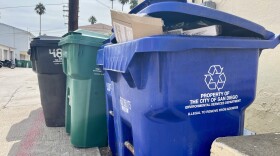Following a weekend that saw California's broadest reopening yet since the coronavirus pandemic shuttered businesses, Gov. Gavin Newsom on Monday defended the state's pace and said the economic harm from isolation can have negative health outcomes, too.
“We have to recognize you can't be in a permanent state where people are locked away for months and months and months and months on end,” he said.
Newsom's remarks came in his first news conference in 10 days, just days after most California counties began reopening bars, wineries, hotels and other services. Roughly three months after Newsom ordered residents statewide to stay home, most counties have now been cleared to open restaurants, shops, movie theaters, zoos, hotels, day camps and gyms. Nail salons, massage studios and other personal care services can reopen Friday in counties where they're approved.
Counties are pushing ahead as cases are climbing across the state, which comes as California ramps up testing. More than 5,000 people have died from the virus in California and more than 150,000 people have been infected. But Newsom and state health officials say the key metrics to watch are the state's hospitalization rate and the percentage of people testing positive for the virus. Both have remained relatively stable in recent weeks, according to state data.
Among people who get tested for coronavirus, between 4% and 5% are shown to have the virus. That's been consistent since mid-May. Previously, when California was only testing people with symptoms, the percentage was much higher.
Meanwhile, every person who gets the virus spreads it to roughly one other person, according to state data. That transmission rate has never gone above 1.4, according to the data.
Since California began reopening on May 8, between 4,000 and 5,000 people have been in the hospital each day. Dr. Dean Winslow, an infectious disease physician at Stanford Health Care, said even a slight increase in hospitalizations is concerning, particularly because it can take weeks after someone is infected for them to end up in a hospital, delaying when new infection data shows up.
But all that data is statewide, and certain counties are seeing more concerning numbers. Newsom warned that as the reopening moves ahead, Californians shouldn't let their guard down and must continue to wear face coverings, wash their hands and stay physically distant if they are gathering with people they don't live with.
“We can manifest the future we want as long as we're smart,” Newsom said. “Total number of positive (cases) are up, not down. You may say, ‘Well, that’s not going to impact me, but you don’t know that.’”
Newsom said state officials are monitoring 13 counties because of spikes in hospitalizations or transmission rates.
In Fresno County, for example, 53 of every 100,000 people have the virus and 8.5% of people who get tested are positive for the coronavirus — both higher than the state allows for reopening. That's been attributed to outbreaks in nursing homes and a state prison.
State officials are also monitoring Los Angeles County, the state’s most populous with 10 million people, for “the possibility of elevated disease transmission,” possibly attributed to higher testing capacity, including testing at 235 nursing homes.
Health officials have not revoked approval for any of the counties that have been cleared to reopen.
Dr. Eyal Oren, a professor of epidemiology and biostatistics at San Diego State University, said he worries people will think life is returning to normal as states reopen even though nothing about the virus and its spread has changed.
“I’m not convinced that we’ve seen a fundamental change, other than the need to open up for obvious political and economic reasons,” he said.
He said positive case rates and hospitalizations are two of many important data points that states should consider. California’s positive test rate falls within an internationally accepted range to show a government is doing enough testing to pick up most cases. But he cautioned that rate is a statewide number and can mask areas where testing is not as robust or the positivity rate is higher.






